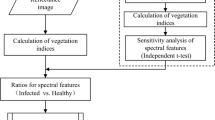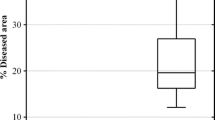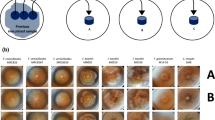Abstract
Cotton root rot, caused by the soilborne fungus Phymatotrichopsis omnivora, is one of the most destructive plant diseases occurring throughout the southwestern United States. This disease has plagued the cotton industry for over a century, but effective practices for its control are still lacking. Recent research has shown that a commercial fungicide, flutriafol, has potential for the control of cotton root rot. To effectively and economically control this disease, it is necessary to identify infected areas within fields so that site-specific technology can be used to apply fungicide only to the infected areas. The objectives of this study were to evaluate unsupervised classification applied to multispectral imagery, unsupervised classification applied to the normalized difference vegetation index (NDVI)and six supervised classification techniques, including minimum distance, Mahalanobis distance, maximum likelihood and spectral angle mapper (SAM), neural net and support vector machine (SVM),for mapping cotton root rot from airborne multispectral imagery. Two cotton fields with a history of root rot infection in Texas, USA were selected for this study. Airborne imagery with blue, green, red and near-infrared bands was taken from the fields shortly before harvest when infected areas were fully expressed in 2011. The four-band images were classified into infected and non-infected zones using the eight classification methods. Classification agreement index values for infected area estimation between any two methods ranged from 0.90 to 1.00 for both fields, indicating a high degree of agreement among the eight methods. Accuracy assessment showed that all eight methods accurately identified root rot-infected areas with overall accuracy values from 94.0 to 96.5 % for Field 1 and 93.0 to 95.0 % for Field 2. All eight methods appear to be equally effective and accurate for detection of cotton root rot for site-specific management of this disease, though the NDVI-based classification, minimum distance and SAM can be easily implemented without the need for complex image processing capability. These methods can be used by cotton producers and crop consultants to develop prescription maps for effective and economical control of cotton root rot.





Similar content being viewed by others
References
Campbell, J. B. (2002). Introduction to remote sensing (3rd ed.). New York, USA: The Guilford Press.
Congalton, R. G., & Green, K. (1999). Assessing the accuracy of remotely sensed data: Principles and practices. Boca Raton, Florida, USA: Lewis Publishers.
Ezekiel, W. N., & Taubenhaus, J. J. (1934). Cotton crop losses from Phymatotrichum root rot. Journal of Agricultural Research, 49(9), 843–858.
Hsu, C.-W., Chang, C.-C., & Lin, C.-J. (2007). A practical guide to support vector classification. National Taiwan University, Taipei. http://ntu.csie.org/~cjlin/papers/guide/guide.pdf. Accessed 12 May 2014.
Intergraph Corporation. (2013). ERDAS Field Guide. Huntsville, Alabama, USA: Intergraph Corporation.
Isakeit, T., Minzenmayer, R. R., Abrameit, A., Moore, G., & Scasta, J. D. (2010). Control of Phymatotrichopsis root rot of cotton with flutriafol. In: Proceedings of Beltwide Cotton Conferences (pp. 200–203). Memphis, Tennessee, USA: National Cotton Council of America.
Isakeit, T., Minzenmayer, R. R., Drake, D. R., Morgan, G. D., Mott, D. A., Fromme, D. D., et al. (2012). Fungicide management of cotton root rot (Phymatotrichopsis omnivora): 2011 results. In: Proceedings of Beltwide Cotton Conferences (pp. 235–238). Memphis, Tennessee, USA: National Cotton Council of America.
Jensen, J. R. (1996). Introductory digital image processing: A remote sensing perspective (2nd ed.). Englewood Cliffs, New Jersey, USA: Prentice-Hall.
Kruse, F. A., Lefkoff, A. B., Boardman, J. W., Heidebrecht, K. B., Shapiro, A. T., Barloon, J. P., et al. (1993). The spectral image processing system (SIPS): Interactive visualization and analysis of imaging spectrometer data. Remote Sensing of Environment, 44, 145–163.
Nixon, P. R., Escobar, D. E., & Bowen, R. L. (1987). A multispectral false-color video imaging system for remote sensing applications. In: Proceedings of the 11th Biennial Workshop on Color Aerial Photography and Videography in the Plant Sciences and Related Fields (Vol. 340, pp. 295–305). Bethesda, Maryland, USA: American Society for Photogrammetry and Remote Sensing.
Richards, J. A. (1999). Remote sensing digital image analysis (p. 240). Berlin, Germany: Springer-Verlag.
Rouse, J. W., Haas, R. H., Shell, J. A., & D. W. Deering. (1973). Monitoring vegetation systems in the Great Plains with ERTS. In: Proceedings of the 3rd ERTS Symposium, NASA SP-351 (pp. 309–317). Washington, DC: U.S. Government Printing Office.
Smith, H. E., Elliot, F. C., & Bird, L. S. (1962). Root rot losses of cotton can be reduced. Publication No. MP361. College Station, Texas, USA: Texas A&M Agricultural Extension Service.
Yang, C. (2012a). A high resolution airborne four-camera imaging system for agricultural applications. Computers and Electronics in Agriculture, 88, 13–24.
Yang, C., Fernandez, C. J., & Everitt, J. H. (2005). Mapping Phymatotrichum root rot of cotton using airborne three-band digital imagery. Transactions of the ASAE, 48(4), 1619–1626.
Yang, C., Fernandez, C. J., & Everitt, J. H. (2010). Comparison of airborne multispectral and hyperspectral imagery for mapping cotton root rot. Biosystems Engineering, 107, 131–139.
Yang, C., Odvody, G. N., Fernandez, C. J., Landivar, J. A., Minzenmayer, R. R., Nichols, R. L., et al. (2012). Monitoring cotton root rot progression within and across growing seasons using remote sensing. In: Proceedings of Beltwide Cotton Conferences (pp. 475–480). Memphis, Tennessee, USA: National Cotton Council of America.
Yang, C., Odvody, G. N., Fernandez, C. J., Landivar, J. A., Minzenmayer, R. R., Nichols, R. L., et al. (2014). Monitoring cotton root rot progression within a growing season using airborne multispectral imagery. Journal of Cotton Science, 18(1), 85–93.
Acknowledgments
This project was partly funded by Texas State Support Committee and Cotton Incorporated, Cary, North Carolina. The authors wish to thank Adam Garcia of Edinburg, Texas and Fred Gomez of USDA-ARS at College Station, Texas for taking the airborne imagery for this study and Jim Forward of U.S. Fish and Wildlife Service at Alamo, Texas for assistance in image registration and ground verification.
Disclaimer
Mention of trade names or commercial products in this article is solely for the purpose of providing specific information and does not imply recommendation or endorsement by the U.S. Department of Agriculture (USDA). USDA is an equal opportunity provider and employer.
Author information
Authors and Affiliations
Corresponding author
Rights and permissions
About this article
Cite this article
Yang, C., Odvody, G.N., Fernandez, C.J. et al. Evaluating unsupervised and supervised image classification methods for mapping cotton root rot. Precision Agric 16, 201–215 (2015). https://doi.org/10.1007/s11119-014-9370-9
Published:
Issue Date:
DOI: https://doi.org/10.1007/s11119-014-9370-9




